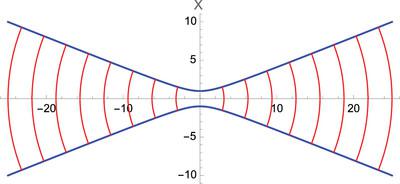The propagation of Hermite–Gauss wave packets in optics and quantum mechanics
IF 3.1
Q2 MULTIDISCIPLINARY SCIENCES
引用次数: 0
Abstract
The two‐dimensional paraxial equation of optics and the two‐dimensional time‐dependent Schrödinger equation, derived as approximations of the three‐dimensional Helmholtz equation and the three‐dimensional time‐independent Schrödinger equation, respectively, are identical. Here the free propagation in space and time of Hermite–Gauss wave packets (optics) or harmonic oscillator eigenfunctions (quantum mechanics) is examined in detail. The Gouy phase is shown to be a dynamic phase, appearing as the integral of the adiabatic eigenfrequency or eigenenergy. The wave packets propagate adiabatically in that at each space or time point they are solutions of the instantaneous harmonic problem. In both cases, it is shown that the form of the wave function is unchanged along the loci of the normals to wave fronts. This invariance along such trajectories is connected to the propagation of the invariant amplitude of the corresponding free wave number (optics) or momentum (quantum mechanics) wave packets. It is shown that the van Vleck classical density of trajectories function appears in the wave function amplitude over the complete trajectory. A transformation to the co‐moving frame along a trajectory gives a constant wave function multiplied by a simple energy or frequency phase factor. The Gouy phase becomes the proper time in this frame.This paper builds a bridge between quantum mechanics (QM) and classical optics in that the identity of the paraxial equation of optics and the Schrödinger equation of QM is shown, the Bohmian trajectories of QM are defined in optics, the Gouy phase of optics is defined in QM and given a new interpretation and The space and momentum wave functions are equivalent along a trajectory.

厄米-高斯波包在光学和量子力学中的传播
由三维亥姆霍兹方程和三维时间无关Schrödinger方程近似导出的二维光学傍轴方程和二维时间相关Schrödinger方程是相同的。本文详细研究了厄米-高斯波包(光学)或谐振子本征函数(量子力学)在空间和时间中的自由传播。格伊相是一个动态相,表现为绝热特征频率或特征能量的积分。波包是绝热传播的,在每一个空间或时间点它们都是瞬时谐波问题的解。在这两种情况下,波函数的形式沿着波前法线的轨迹是不变的。这种沿轨迹的不变性与相应的自由波数(光学)或动量(量子力学)波包的不变性振幅的传播有关。结果表明,范弗利克经典轨迹密度函数出现在整个轨迹上的波函数振幅中。沿轨迹向同运动坐标系的变换得到一个常数波函数乘以一个简单的能量或频率相位因子。格伊相变成了这个坐标系中的固有时。本文在量子力学与经典光学之间架起了一座桥梁,证明了光学的近轴方程与量子力学的Schrödinger方程是一致的,在光学中定义了量子力学的波希米亚轨迹,在量子力学中定义了光学的古伊相并给出了新的解释,空间波函数和动量波函数沿轨迹是等价的。
本文章由计算机程序翻译,如有差异,请以英文原文为准。
求助全文
约1分钟内获得全文
求助全文

 求助内容:
求助内容: 应助结果提醒方式:
应助结果提醒方式:


